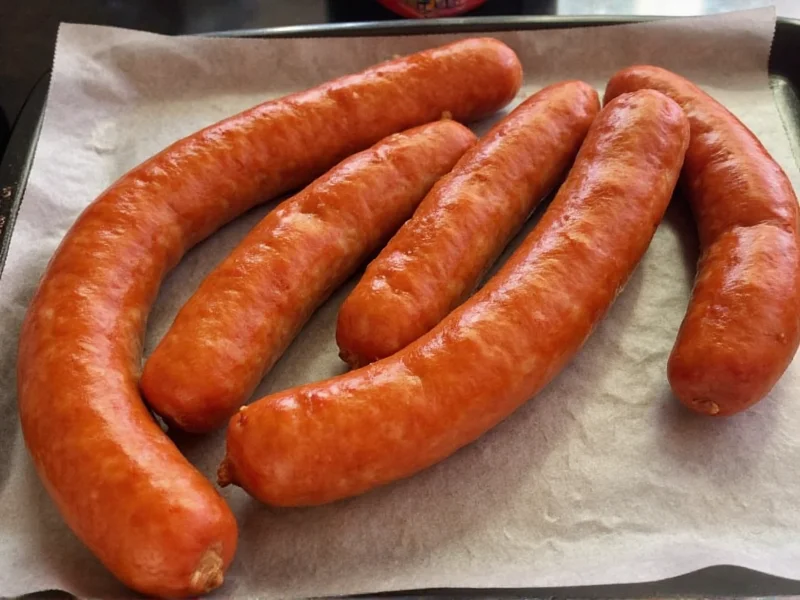Preheat your oven to 400°F (200°C). Arrange raw sausage links on a parchment-lined baking sheet, leaving space between them. Bake for 20-25 minutes, flipping halfway, until internal temperature reaches 160°F (71°C). For frozen sausages, add 5-8 minutes. The sausages should be golden brown with a crispy exterior and juicy interior.
Discover the foolproof method for achieving perfectly cooked sausage links in your oven every time. Unlike stovetop cooking, oven baking delivers evenly cooked results with minimal effort and cleanup. This comprehensive guide covers everything from temperature settings to timing, ensuring your sausage links develop that ideal crispy exterior while maintaining a juicy, flavorful interior.
Why Oven Baking Is the Best Method for Sausage Links
Oven baking sausage links offers several advantages over traditional cooking methods. The dry, consistent heat of your oven ensures even cooking throughout without the risk of burning that often happens with pan-frying. You'll achieve that desirable crispy texture on all sides simultaneously, rather than having to constantly rotate sausages in a skillet. Plus, baking requires minimal hands-on time—simply arrange the sausages, set the timer, and let your oven do the work while you prepare other meal components.
Essential Tools and Ingredients
Before you begin cooking sausage links in oven, gather these basic items:
- Baking sheet or roasting pan
- Parchment paper or aluminum foil (for easy cleanup)
- Meat thermometer (critical for food safety)
- Tongs for flipping
- Wire rack (optional, for extra crispiness)
Step-by-Step Oven Baking Instructions
Follow these detailed steps for perfectly cooked sausage links every time:
- Preheat your oven to 400°F (200°C). This temperature provides the ideal balance between browning and thorough cooking.
- Prepare your baking sheet by lining it with parchment paper or aluminum foil. For crispier results, place a wire rack on the baking sheet.
- Arrange sausage links in a single layer with at least ½ inch of space between each link. Overcrowding prevents proper air circulation and leads to steaming rather than baking.
- Bake for 10 minutes, then carefully flip each sausage link using tongs.
- Continue baking for another 10-15 minutes until the internal temperature reaches 160°F (71°C).
- Rest for 3-5 minutes before serving to allow juices to redistribute.
Cooking Time and Temperature Guide
| Sausage Type | Oven Temperature | Approximate Time | Internal Temp |
|---|---|---|---|
| Standard pork sausage links | 400°F (200°C) | 20-25 minutes | 160°F (71°C) |
| Chicken or turkey sausage | 375°F (190°C) | 25-30 minutes | 165°F (74°C) |
| Frozen sausage links | 400°F (200°C) | 25-33 minutes | 160°F (71°C) |
| Thick sausage links (1.5" diameter) | 375°F (190°C) | 28-35 minutes | 160°F (71°C) |
Food Safety: The Critical Internal Temperature
Proper internal temperature is non-negotiable when cooking sausage links in oven. Raw pork sausages must reach 160°F (71°C), while poultry sausages require 165°F (74°C). Using a reliable meat thermometer is essential—color alone cannot indicate doneness. Insert the thermometer into the thickest part of the sausage, avoiding contact with the baking sheet. Undercooked sausage poses serious food safety risks, while overcooked sausage becomes dry and tough.
Pro Tips for Perfect Oven-Baked Sausage Links
Elevate your sausage cooking technique with these professional tips:
- Don't pierce the sausages before or during cooking—this releases precious juices and leads to dry results
- For extra crispiness, place sausages on a wire rack elevated above the baking sheet
- Rotate the pan halfway through cooking for even browning, especially in ovens with hot spots
- Add vegetables to the same pan during the last 15 minutes for a complete sheet pan meal
- Let sausages rest for 3-5 minutes after removing from oven to allow juices to redistribute
Avoiding Common Oven Sausage Mistakes
Many home cooks make these preventable errors when baking sausage links:
- Overcrowding the pan—leads to steaming instead of baking and prevents proper browning
- Not preheating the oven—results in uneven cooking and longer cooking times
- Skipping the flip—causes uneven browning on one side
- Guessing doneness—always use a meat thermometer for food safety
- Starting with cold sausages—let refrigerated sausages sit at room temperature for 15 minutes before baking
Serving Suggestions and Pairings
Oven-baked sausage links pair beautifully with numerous sides. Classic combinations include:
- Breakfast: Serve with scrambled eggs, roasted potatoes, and fresh fruit
- Lunch: Slice and add to sandwiches with caramelized onions and peppers
- Dinner: Pair with sauerkraut, mustard, and crusty bread for a German-inspired meal
- Sheet Pan Dinner: Roast with potatoes, bell peppers, and onions for a complete meal
Storing and Reheating Leftover Sausages
Proper storage maintains quality and safety of cooked sausage links:
- Refrigeration: Store cooled sausages in an airtight container for up to 4 days
- Freezing: Place cooled sausages in freezer bags for up to 3 months
- Reheating: For best results, reheat in a 350°F (175°C) oven for 10-15 minutes or until heated through. Avoid microwaving, which can make sausages rubbery.
Special Considerations for Different Sausage Types
While the basic method remains consistent, different sausage varieties require slight adjustments when cooking sausage links in oven:
- Pork sausages: Can handle higher temperatures (400°F) for crispier results
- Poultry sausages: Require lower temperatures (375°F) and slightly longer cooking to prevent drying
- Frozen sausages: Add 5-8 minutes to cooking time without thawing first
- Pre-cooked sausages: Only need 10-15 minutes at 350°F to heat through and develop color











 浙公网安备
33010002000092号
浙公网安备
33010002000092号 浙B2-20120091-4
浙B2-20120091-4